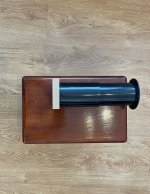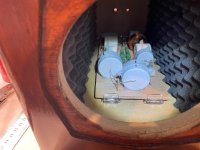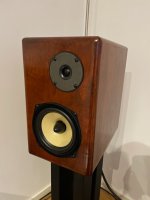Yes,by all means reduce the sensitivity! 😀 The tweeter level is a smidge high and the woofer rise to meet it is not desirable. Flatten the woofer output and your impedance gets better. Lower the tweeter level and the balance becomes fuller
I don't see what's so wrong with the present impedance. The impedance only drops below 6 ohms between 1kHz and 3.1kHz. Overall, the impedance is a quite benign load as far as impedances go.
Thanks for your help witwald! Now I understand a little more how to get about with VituixCAD. I am a prof. classic musician not really trained in this terminology. But I learn quickly. Anyway, the port/vent I prepared for was 7 cm in diameter, because Monacor sort of pointed in that direction when I read about it. Not to easy to change at this point. The port I bought can be extended to 26cm and according to your figures that will generate 45,5hz. Intention for these speakers will be in my workstudio about 18sqm. Of course its not good if there will a lot of turbulence but I am not sure how to understand the figures. Also I am quite tempted to try the crossover from your post #10, need to order some new values first.That's great news that they were the internal dimensions! The internal volume comes to around 15.9 litres, which seems plenty for the Monacor SPH-165KEP based on the Thiele–Small parameters in the datasheet. With a Dv = 7.0cm vent diameter, the VituixCAD estimates the vent length to be Lv = 35.1cm, which is quite long. The resulting bass response curve for a vent tuning frequency of Fb = 40.0Hz is shown below. The −3dB point is F3 = 44.3Hz.
View attachment 1354903
If we swap to a vent diameter of Dv = 5.0cm, the estimated vent length drops considerably to Lv = 16.0cm. With this configuration, the driver's Xmax is reached with 18W (re 8 ohms) of input power. At the same time, the maximum air velocity in the vent hovers around the lower of VituixCAD's guidelines (turbulence warning).
By the way, the following VituixCAD table shows the set of Thiele–Small parameters that I took from the woofer's datasheet.
View attachment 1354908
Hi, I follow the discussion with ericsquires with great interest. I must ask if you changed anything in the crossover layout from post #10? Mine looks now as in post #16I'm not entirely sure that we should try and reduce the output of the woofer to reduce the hump in its filter's transfer function. That will reduce the sensitivity of the system in the midrange area, which is potentially more undesirable.
Here the raw woofer response has a bit of a downward tilt. A little bit of filtering EQ is not unusual when dealing with driver natural frequency response functions.
Below is a plot of the woofer impedance curve with the Zobel network in place. It has flattened the rising impedance of the woofer quite well. The impedance is about 7 ohms between 200Hz and 2000Hz, and then log-linearly rises to 9 ohms at 20kHz.
View attachment 1354937
I'm curious as to where you read about the recommended port size and enclosure size for the Monacor SPH-165KEP. The only one I could find was the one below, which matches your enclosure volume very closely. If the tuning frequency is a bit high, the bass will be boosted by a dB or two about 10Hz above the tuning frequency. This shouldn't be a major issue, especially if you have a bass tone control on your amplifier.
The simulations in VituixCAD seem to indicate that this driver hits its Xmax rating around the same time as the port turbulence warning is crossed. Not sure how that might affect sound quality, but at moderate listening levels things should be okay.
After doing a bit of digging, it turns out that the HP50 reflex tube mentioned below is tapered, with an inside diameter of 50mm that narrows down to 44mm.
From https://www.lautsprechershop.de/chassis/monacor_woofer_en.htm:

The simulations in VituixCAD seem to indicate that this driver hits its Xmax rating around the same time as the port turbulence warning is crossed. Not sure how that might affect sound quality, but at moderate listening levels things should be okay.
After doing a bit of digging, it turns out that the HP50 reflex tube mentioned below is tapered, with an inside diameter of 50mm that narrows down to 44mm.
From https://www.lautsprechershop.de/chassis/monacor_woofer_en.htm:
The crossover layout as per post #10 is the most up-to-date one that I posted. The impedance curves in post #16 correspond to it.Hi, I follow the discussion with ericsquires with great interest. I must ask if you changed anything in the crossover layout from post #10? Mine looks now as in post #16
I tried an alternative Zobel design, which increased the woofer impedance at high frequencies. It did not produce any significant increase in the impedance around 2.2kHz. However, it resulted in a little bit more filter EQ in the woofer crossover, so I didn't bother pursuing it any further.
Hi, I bought mine in Sweden, from i guess the the importer, at https://www.eluxson.se/produktkategorier/348-sph-165kep.html, where it says "Lådförslag" meaning box suggestions, you can read the port dimensions. But I mean your suggestion sounds brilliant. I will check it out. Thanks! PS ...and I just saw they also have the suggested tube HP50I'm curious as to where you read about the recommended port size and enclosure size for the Monacor SPH-165KEP. The only one I could find was the one below, which matches your enclosure volume very closely. If the tuning frequency is a bit high, the bass will be boosted by a dB or two about 10Hz above the tuning frequency. This shouldn't be a major issue, especially if you have a bass tone control on your amplifier.
The simulations in VituixCAD seem to indicate that this driver hits its Xmax rating around the same time as the port turbulence warning is crossed. Not sure how that might affect sound quality, but at moderate listening levels things should be okay.
After doing a bit of digging, it turns out that the HP50 reflex tube mentioned below is tapered, with an inside diameter of 50mm that narrows down to 44mm.
From https://www.lautsprechershop.de/chassis/monacor_woofer_en.htm:
View attachment 1355039
Now I also realize that I have mixed up the port I bought. It is the MBR-70 and I obviously forgott its 66mm in diameter inside and not 70 that I said. Sorry. But it seems to be in the right direction. At 25cm lenght it will generate 44hz. With the HP50 it will be around 37hz at 14cm. How strange this sounds in my ears...shorter and narrower generates lower frequenz, sort of upside down...🙂
I will use Vb = 16.6 litres as the internal enclosure volume (accounting for volume of MDF brace and the vent tube). For the purposes of setting the vent correction factor, k, I have assumed that one end is flanged (by the rear cabinet wall) and the other free, so k = 0.732 is an accepted value (see http://www.troelsgravesen.dk/vent_tuning.htm). My previous calculations somehow managed to use an incorrect value for k; sorry about that.
With an Lv = 25cm long tube with Dv = 6.6cm internal diameter, VituixCAD estimates the box tuning frequency to be Fb = 44.9Hz, producing a 1-dB peaked response with a −3dB point of F3 = 46.2Hz. The predicted response is shown below.

For 20W input (re 8 ohms), we will reach Xmax of the woofer. The peak vent velocity stays under the turbulence warning level.

Keep in mind that the clearance between the interior end of the port tube and the rear of the front baffle will be about 8.5cm (I took a guess at and allowed for a 2.5cm rear wall thickness). The end correction associated with the unflanged end of the tube is k = 0.307, so there is an oscillating "plug" of air whose "length" is about 0.307x6.6 = 2.0cm. This reduces the internal "clearance" to 6.5cm, which still seems to be adequate. It's quite the compact loudspeaker enclosure but with a generous amount of bass extension for its size.
If we change the port tube to the HP50 and set Lv = 14cm, we have two diameters to contend with: Dvo = 5.0cm and Dvi = 4.4cm. Our formula doesn't handle this case. As Dv appears as Dv^2 in the vent tuning formula, I will assume that an estimate for Dv for the tapered tube can be obtained from the geometric mean using Dv = sqrt(Dvo x Dvi) = 4.7cm. I'll simply proceed to ignore any potential corrections to the end correction factor. 🙂
Using the dimensions discussed above, the predicted low-frequency response is shown below. The box tuning frequency is estimated to be Fb=41.8Hz, producing a 0.25-dB peaked response with a −3dB point of F3=44.3Hz.

With an Lv = 25cm long tube with Dv = 6.6cm internal diameter, VituixCAD estimates the box tuning frequency to be Fb = 44.9Hz, producing a 1-dB peaked response with a −3dB point of F3 = 46.2Hz. The predicted response is shown below.
For 20W input (re 8 ohms), we will reach Xmax of the woofer. The peak vent velocity stays under the turbulence warning level.
Keep in mind that the clearance between the interior end of the port tube and the rear of the front baffle will be about 8.5cm (I took a guess at and allowed for a 2.5cm rear wall thickness). The end correction associated with the unflanged end of the tube is k = 0.307, so there is an oscillating "plug" of air whose "length" is about 0.307x6.6 = 2.0cm. This reduces the internal "clearance" to 6.5cm, which still seems to be adequate. It's quite the compact loudspeaker enclosure but with a generous amount of bass extension for its size.
If we change the port tube to the HP50 and set Lv = 14cm, we have two diameters to contend with: Dvo = 5.0cm and Dvi = 4.4cm. Our formula doesn't handle this case. As Dv appears as Dv^2 in the vent tuning formula, I will assume that an estimate for Dv for the tapered tube can be obtained from the geometric mean using Dv = sqrt(Dvo x Dvi) = 4.7cm. I'll simply proceed to ignore any potential corrections to the end correction factor. 🙂
Using the dimensions discussed above, the predicted low-frequency response is shown below. The box tuning frequency is estimated to be Fb=41.8Hz, producing a 0.25-dB peaked response with a −3dB point of F3=44.3Hz.
@witwald I must really say you did a fantastic job here, thank you so much! I have learned quite a lot this last few days. Also, your estimation of 8,5 cm cleranse to front wall is perfectly right. The article by Troels G. was also very interesting to read. I actually did correspond with him on mail a few years ago regarding a problem I had with my Proacs R1s. Hence, I opened them and found that they used a flanged tube, looking as those I made for this project. Since it's a long vent of 25 cm I will try first, I thought it could be a good idea. Interesting was that ProAc uses a rather thick foamrubber and nothing else around the walls. Yesterday I did order the components for the crossover, mainly Mundorf EVO oil serie 450v but also some Jantzen parts. Not the cheapest parts but certainly not the more expensive ones. It will take some time to get it all, but am looking forward to hear and also measure this with REW. I will post you when its ready. Thanks!
Attachments
So finally ready! I must say they sound fantastic. There was a very good match for the elements I used. Already from start they sounded good with components from Mundorf and Jantzen. There was a little muddiness in the overtones from violins and pianos for example, and since I am very critical I decided tho tweak a little. At present time I have a pair of ProAc Response 1s and also a pair of SystemAudio Saxon 70 (sort of fullrange floor standers) as references. When I measure my new speakers, I will call them Proto2, with REW, the curve looked very much like the ProAcs with a slight dip of 5-6db around 2000hz but on the other hand extended much more below. The bas was also quite good from start.
So, my so called tweaks was that I changed the first capacitor going to the tweeter (#10)to a value of 3,9uf. That cleared up the slight muddiness, and I also changed that capacitor from Mundorf Evo Oil to Jantzen Superior Z-cap. That was quite an amazing improvement. I could not have guessed. Now I can recognize my own violin from recordings. I also experimented with various damping. Apart from the normal damping of the walls, I found that if I put 90gr of glassfiberwool (I forgot the English word for it..) in the bas chamber it sounded very good and very balanced. They really sound like the whole wall is gone!
So happy New Year to @witwald for all the help with this project.
So, my so called tweaks was that I changed the first capacitor going to the tweeter (#10)to a value of 3,9uf. That cleared up the slight muddiness, and I also changed that capacitor from Mundorf Evo Oil to Jantzen Superior Z-cap. That was quite an amazing improvement. I could not have guessed. Now I can recognize my own violin from recordings. I also experimented with various damping. Apart from the normal damping of the walls, I found that if I put 90gr of glassfiberwool (I forgot the English word for it..) in the bas chamber it sounded very good and very balanced. They really sound like the whole wall is gone!
So happy New Year to @witwald for all the help with this project.
Attachments
- Home
- Loudspeakers
- Multi-Way
- Help to raise impedance in a 2way system




